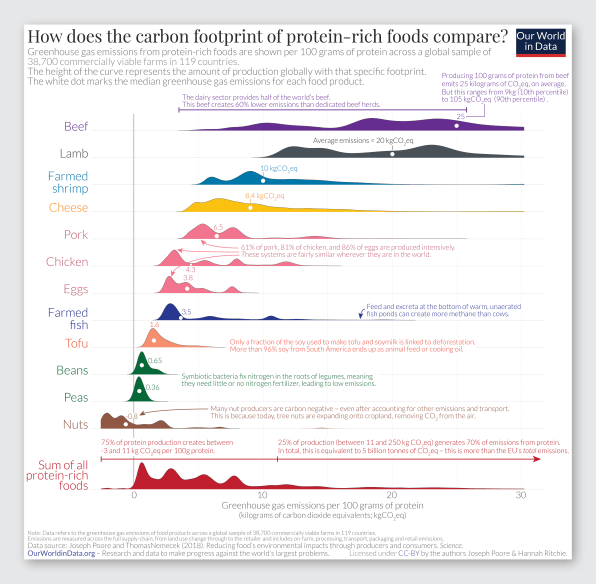Which Is The Best Animal Protein For The Environment
If you want to reduce your personal carbon footprint, y'all might merchandise in a car trip for a ride on public transit, or swing past a second-paw vesture store rather than buy fast fashion. You might also take a closer look at what you eat. Food production accounts for 1-quarter of global greenhouse gas emissions, and the meat and dairy industries are a big reason why. But if you aren't ready or willing to give up meat—which could halve the carbon footprint of your nutrition in one fell swoop—should you consume "sustainable" animal options, change what kinds of meat you're eating, or just opt for fewer meat-filled meals?
Hannah Ritchie, an environmental researcher at Our Earth In Data, an online science publication associated with the Academy of Oxford, sought to answer that exact question. She found that eating less meat is most always a improve environmental choice, but the choice of meat and where that meat is sourced from matters. Eating plant-based protein, though, makes the biggest difference—no thing where your beans and tofu come from.
Understanding the environmental impacts of our diet can seem overwhelming. There are a lot of factors at play: country employ, organic or nonorganic farming, how far that food is shipped to you lot, how much plastic information technology's packaged in. Only it really comes downwards to i crucial factor: what we eat. "Most of the advice out at that place (even by organizations such as the Un) of 'eat local, consume organic, use less plastic' brand only a small divergence (sometimes fifty-fifty make things worse)," Ritchie says via electronic mail. "We need to make changes that have a large touch on, and dietary modify is a large one."

The biggest chunk of our food-related emissions, Ritchie has previously explained on Our Globe in Data, comes non from transport or packaging simply because of country-use change, which is when habitable land has been turned into agricultural country. But a lot of the numbers that are reported about carbon emissions associated with food product, whether of peas or beefiness, are global averages. That might lead people to think that their burger sourced from a local, depression-impact producer is an exception—and better than plastic-wrapped, internationally sourced found protein—thereby justifying their meat consumption.
Merely that's not quite right, Ritchie says. Fifty-fifty the almost sustainable meat and dairy producers have a bigger carbon footprint than the worst constitute protein manufacturers. "So even your tofu shipped to you across the globe and wrapped in plastic will have a lower footprint than meat," she says.
Ritchie created a graphic that compares the carbon footprint of all types of proteins, and includes the caveat that that carbon footprint can change, depending on how and where information technology's produced. The white dot for each protein on the graphic represents the global average. If you lot're concerned about how much plant-protein you'd have to eat to match your meat intake, though, and if that would skew the environmental benefits, don't worry; Ritchie factored that in, every bit well.
"Rather than comparing products in terms of kilograms or calories, here we do a direction comparing of per 100 grams of poly peptide," she says. "And nosotros did non include sources of 'lower-quality' poly peptide such equally cereals and grains in this comparison because they are not an platonic source of protein, specially in terms of their amino acid profile. But in a good balanced diet of legumes (peas, beans), tofu, nuts, and grains, you lot tin certainly meet your protein needs."
The graph shows that the carbon footprint of your meat tin can vary, and that'southward because some producers practise make an endeavour to exist more sustainable. Simply what is "sustainable" meat, anyway? "In other words, what meats are produced in such a way that they have the lowest carbon footprint we could have for that given production. There are many aspects that come into 'sustainability': state, h2o, free energy, soil fertility, economic sustainability, and then this is a very narrow view of carbon emissions," Ritchie says. The carbon footprint of beef, for example, isn't the aforementioned everywhere. Southward America-sourced beef has a college carbon footprint due to rampant deforestation at that place; in New Zealand, French republic, and the U.M., it'due south lower thanks to better subcontract direction practices.
Still, eating less beef—and choosing craven, eggs, and fish, which can have a "reasonably depression," carbon footprint—is better. "They can be part of a relatively depression-carbon diet if eaten in moderation. This level of consumption though would exist much lower than nosotros currently see in most Western countries," Ritchie adds. "So average consumption of meat would need to be reduced significantly; only for the small amounts we do eat, it's all-time if we seek out options which are as 'sustainable' as we tin."
Those nonetheless aren't as environmentally friendly every bit plant-based proteins, though. It may seem counterintuitive to buy internationally sourced beans at the supermarket rather than a cutting of beef from your local farmer. Nosotros've been told to shop local and get zero waste, merely ultimately, this research finds, the biggest environmental factor lies in what it took to produce those 100 grams of protein.
Source: https://www.fastcompany.com/90461008/this-graph-will-show-you-the-carbon-footprint-of-your-protein
Posted by: henselpaing1953.blogspot.com

0 Response to "Which Is The Best Animal Protein For The Environment"
Post a Comment